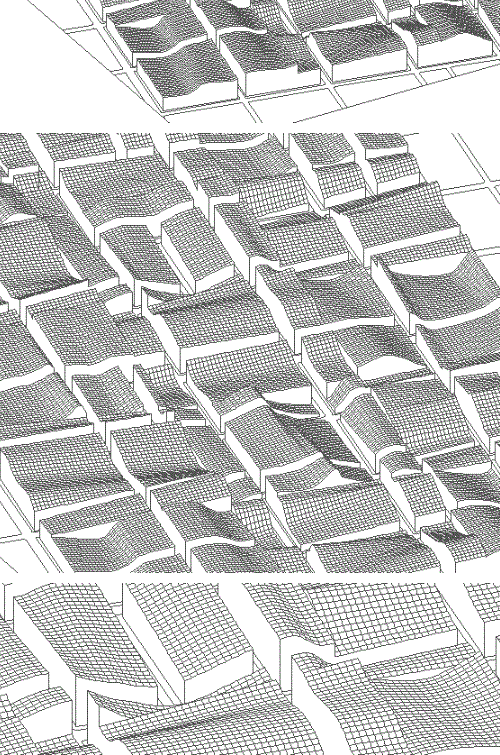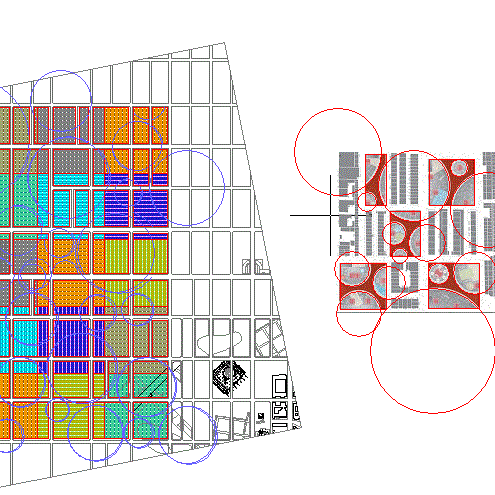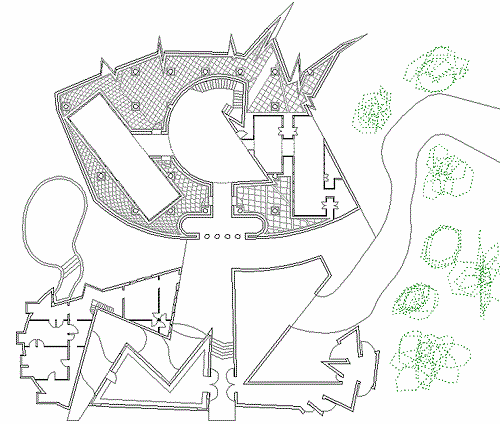

| |


Last night, finally got around to investigating and experimentally implementing the technique underlying OMA's Apraksin Dvor design, and while doing so it gradually . . . déjà vu.
2015.03.22 11:27
Take a Tour of Ancient Rome, 320 CE
Unfortunately, the narrative contains significant factual errors and the presentation overall does little to elucidate what was really going on in Rome 320CE. Under the reign of Maxentius (a usurper 306-312) Rome and southern Italy and northern Africa was pretty much cut-off from the rest of the Empire then ruled by a tetrarchy from four other 'capitals'. Rome's survival then was largely contingent on grain imports from northern Africa and the city overall was starting to be disenfranchised. After Constantine's defeat of Maxentius 28 October 312 the Imperial sanctioning of Christianity in Rome begins, with Rome's largest construction projects then being what's now St. John Lateran (312-318) and St. Peter's (319-330) concomitant with the gradual disenfranchisement of Rome's pagan establishment.
Like any large city, things get old and nothing lasts forever.
Between 312 and 326 Constantine spent what amounts to less than one year on three different occasions in Rome, thus the Palatine was largely abandoned (And Constantine did see the Arch of Constantine!) Helena and Eutropia, Constantine's mother and mother-in-law respectively, lived in Rome during that time (at a large Imperial villa at the southeast edge of the city, "down the street" from St. John Lateran) supervising, if not also designing, all the new Christian construction, much of which done on Imperially owned land outside the walls.
For that video to be more correct, you would need to see a fair number of the buildings already starting to fall apart.
2015.03.22 11:35
Pondering the cultural value of Frank Gehry's Winton Guest House
muse[um]ification
2015.03.22 11:46
Take a Tour of Ancient Rome, 320 CE
I forgot to mention that Constantine's mother-in-law, Eutropia, was the mother of Maxentius.
The Paradigm-Shifting Architectures of Closely Related Imperials
2015.03.22 18:03
Take a Tour of Ancient Rome, 320 CE
Given Frischer's credentials, the errors and the more than slightly romanticized depiction of the video now only appear greater. If I'm aware of the more accurate history of Rome 320CE, then Frischer certainly should be! And the clear evidence that Frischer is not aware of the more accurate history is only to his discredit, not mine.
I wonder how much the word 'romanticized' comes from a false view of Rome itself. Ha.
When I heavily participated within the late-antique email list serve (around 10 years ago), every so often some older professor would vehemently disagree with some of my suppositions/questions about the architectural/political circumstances during the various reigns of Constantine, and, through back-and-forths with other participants and following suggestions as to where some information/answers might be found, it always turned out that my suppositions pointed to much more likely scenarios as to what actually went on back then.
| |
2015.03.22 18:25
Pondering the cultural value of Frank Gehry's Winton Guest House
I suspect the Morandi connection is more of a mask. The clear precedents for what Gehry did with the Guest House are Kahn's Dominican Motherhouse for the Sisters of St. Catherine de Ricci (1965-68) and Stirling and Wilford's Berlin Science Center (1979). Even my own Cooper & Pratt House (1982) may predate (or was being designed at exactly the same time as) the Winton Guest House (1982-87).

2015.03.22 18:30
Pondering the cultural value of Frank Gehry's Winton Guest House
And I forgot to mention Venturi and Rauch's Brant House, Bermuda (1975).
2015.03.22 20:44
Pondering the cultural value of Frank Gehry's Winton Guest House
Not just in plan. Kahn's, Stirling/Wilford's and Venturi/Rauch's designs are also studied volumes. The verticality of Kahn's design in particular precurses Gehry's. And I certainly don't buy that Gehry was somehow uninterested in or unaware of what other architecture was being designed and built at the time or just prior--let's just be realistic about that.
The Cooper & Pratt House was never built. It was for an in-office competition for a spec house. The 'developer'/judge picked a design that looked just like a farmhouse. Within a half year the designer of the 'farmhouse' was fired, and his design was eventually handed over to me. After a day of looking over the design, I had to ask my boss, Roger Pratt, for 10 minutes of his time so I could show him what I found, which were a myriad of functional and programmatic errors and mis-designs. Roger agreed and said, "Well, just fix it." A couple days later I showed Roger what I had done, which turned out to be a pretty decent redesign, and he took his time looking over the drawings with this odd look on his face, and then he looked directly in my face and asked, "How did you do that?"
2015.03.22 21:35
Pondering the cultural value of Frank Gehry's Winton Guest House
Let's hope so. The whole point of looking at precedents is to learn from and be inspired by them, and subsequently execute a design that adds something more to them.
2015.03.22 21:43
Pondering the cultural value of Frank Gehry's Winton Guest House
And here's something interesting regarding the massing of Kahn's Motherhouse design.
2015.03.23 14:50
Why do all hipsters look the SAME?
Orhan, in what sense do you see Vertical farms, Poche, Blobs, Hedonistic urbanism, Parametric buildings, New Urbanism, Old Urbanism, etc, etc, as trends that evolve into mainstream? I can see New Urbanism as having moved much more into the category of mainstream, but the rest look like trends that may last a year of two and then forgotten and/or replaced by some new trend. (The latest issue of Log (33) exemplifies a new trend replacing an older trend.)
Rather than following the 'evolution' of trends, it might be more valuable/realistic to look for and call out the mutations within the design continuum, for it seems that those designs/buildings that are somehow unexpected and/or just different enough from the trends/norms are what produce more substantial effects on the further developing of the design continuum.
2015.03.23 17:57
FRCH Design Worldwide upgrades Zaha Hadid's Contemporary Arts Center lobby in Cincinnati
I've never been there, but it seems that whatever distinction the lobby may have originally had is now lost. What's there now has the look of something that isn't quite able to manifest any real sense of distinction. Perhaps "it doesn't look like anything beyond temporary" describes it best.
2015.03.25 14:06
Morphosis unveils plans for "Minimalist" skyscraper next to Zumthor's Therme Vals
Just one is not enough.
2015.03.25 19:31
Morphosis turns Vals into "Skyscraper Village"
And here I thought I had designed the worst piece of architecture in the history of architecture.

Would it help if I told you the site for this house is also in Switzerland, like just down the valley?
|